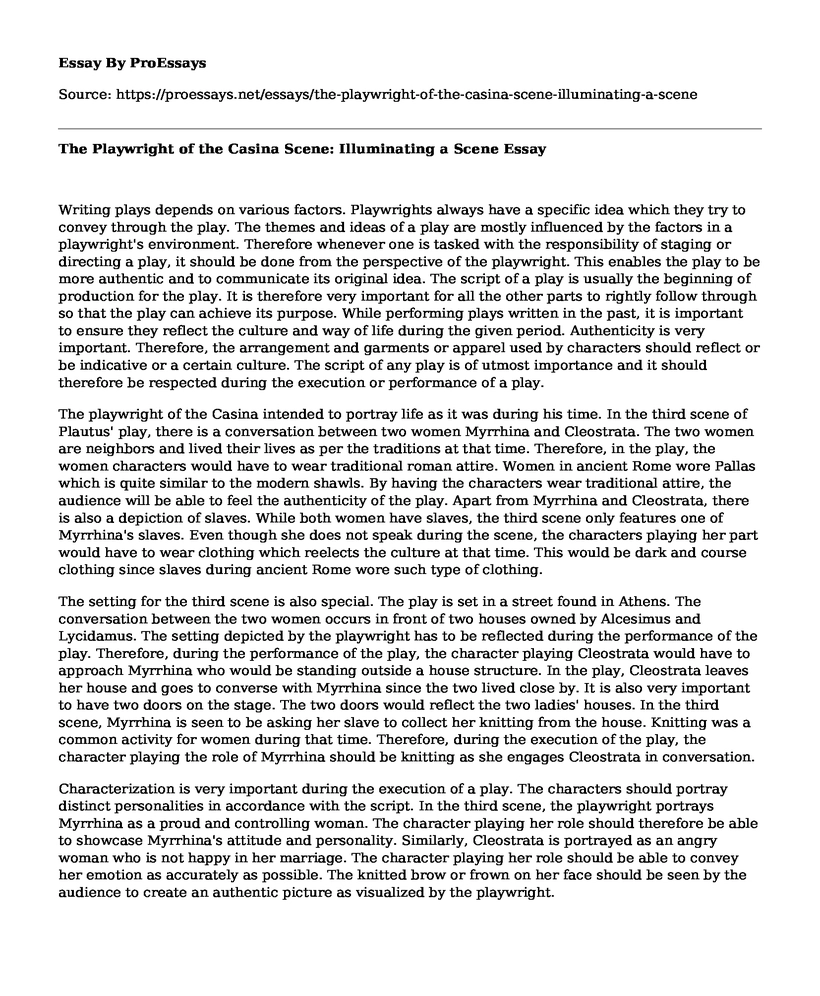Writing plays depends on various factors. Playwrights always have a specific idea which they try to convey through the play. The themes and ideas of a play are mostly influenced by the factors in a playwright's environment. Therefore whenever one is tasked with the responsibility of staging or directing a play, it should be done from the perspective of the playwright. This enables the play to be more authentic and to communicate its original idea. The script of a play is usually the beginning of production for the play. It is therefore very important for all the other parts to rightly follow through so that the play can achieve its purpose. While performing plays written in the past, it is important to ensure they reflect the culture and way of life during the given period. Authenticity is very important. Therefore, the arrangement and garments or apparel used by characters should reflect or be indicative or a certain culture. The script of any play is of utmost importance and it should therefore be respected during the execution or performance of a play.
The playwright of the Casina intended to portray life as it was during his time. In the third scene of Plautus' play, there is a conversation between two women Myrrhina and Cleostrata. The two women are neighbors and lived their lives as per the traditions at that time. Therefore, in the play, the women characters would have to wear traditional roman attire. Women in ancient Rome wore Pallas which is quite similar to the modern shawls. By having the characters wear traditional attire, the audience will be able to feel the authenticity of the play. Apart from Myrrhina and Cleostrata, there is also a depiction of slaves. While both women have slaves, the third scene only features one of Myrrhina's slaves. Even though she does not speak during the scene, the characters playing her part would have to wear clothing which reelects the culture at that time. This would be dark and course clothing since slaves during ancient Rome wore such type of clothing.
The setting for the third scene is also special. The play is set in a street found in Athens. The conversation between the two women occurs in front of two houses owned by Alcesimus and Lycidamus. The setting depicted by the playwright has to be reflected during the performance of the play. Therefore, during the performance of the play, the character playing Cleostrata would have to approach Myrrhina who would be standing outside a house structure. In the play, Cleostrata leaves her house and goes to converse with Myrrhina since the two lived close by. It is also very important to have two doors on the stage. The two doors would reflect the two ladies' houses. In the third scene, Myrrhina is seen to be asking her slave to collect her knitting from the house. Knitting was a common activity for women during that time. Therefore, during the execution of the play, the character playing the role of Myrrhina should be knitting as she engages Cleostrata in conversation.
Characterization is very important during the execution of a play. The characters should portray distinct personalities in accordance with the script. In the third scene, the playwright portrays Myrrhina as a proud and controlling woman. The character playing her role should therefore be able to showcase Myrrhina's attitude and personality. Similarly, Cleostrata is portrayed as an angry woman who is not happy in her marriage. The character playing her role should be able to convey her emotion as accurately as possible. The knitted brow or frown on her face should be seen by the audience to create an authentic picture as visualized by the playwright.
Conclusion
Conclusively, the appearance of the characters, their settings, and their dressing code plays a significant role towards the main theme of the play. In the Casina scene the playwright has succeeded in presenting the social issues that affect the community through the characters, and alongside with the attires, characterization and settings presented, the audience can have a complete visual understanding of the happenings and also make judgments of different situations. The illumination of the scene also was supported by the different moods of the characters, time of settings and the conversations in context. The setting of the play is in the ancient Greece, starting from the attires and the surrounding objects, this is to mean that there should not be any modern at the scene of the act, to avoid confusion to the reader and the audience. Laos the settings of the play should be aligned with the moods and the context. Developing and understanding of illumination of the scene enhance the readers' understanding of the scenes, and they can contemplate and take position on the issues surrounding the play.
Cite this page
The Playwright of the Casina Scene: Illuminating a Scene. (2022, Sep 05). Retrieved from https://proessays.net/essays/the-playwright-of-the-casina-scene-illuminating-a-scene
If you are the original author of this essay and no longer wish to have it published on the ProEssays website, please click below to request its removal:
- Art Work Details and Description: Mona Lisa
- Bulworth Film Analysis Essay
- Persian Film Festival Essay Example
- Paper Example on Art and Photography
- Awe of Labor: How Walt Whitman's 'I Hear America Sing' Celebrates Workforce - Essay Sample
- Documentary Analysis Essay on Huey Long
- Expanding First Amendment Reach in the Age of Social Media - Essay Sample







